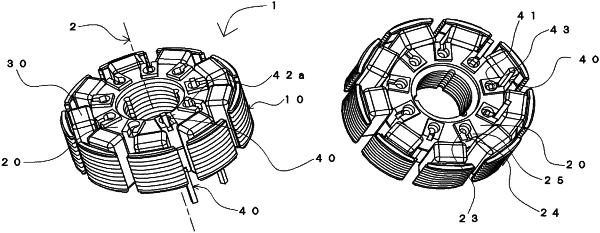| CPC H02K 3/522 (2013.01) [H02K 7/116 (2013.01); H02K 2203/03 (2013.01)] | 10 Claims |

|
1. A stator, which is a component of a brushless motor, and which generates a rotating magnetic field with respect to a rotor that can rotate around a central axis, wherein:
the stator has
a core comprising a magnetic body,
an insulating member that covers the core,
a winding that is wound on the insulating member, and
a conductive member for supplying drive power to the winding;
wherein the core includes a circular portion and a plurality of pole teeth extending from the circular portion in a radial direction of the circular portion and formed along a circumferential direction of the circular portion;
the conductive member comprises
a joining part that is in contact with a lower surface of the insulating member,
an insertion part that extends axially upward from one end of the joining part, and
a board connection part descending axially downward from the other end of the joining part; and
wherein the insulating member covers the circular portion and the pole teeth, has a penetrated part for penetration in the axial direction by the insertion part, and a receiving groove for receiving the joining part;
the penetrated part is provided in a vicinity of the circular portion between the pole teeth:
the receiving groove extends from the penetrated part to a peripheral edge of the insulating member;
the joining part is arranged in the receiving groove in which said other end of the joining part extends to the peripheral edge of the insulating member; and
the insertion part extends into the penetrated part from below the insulating member, penetrates the penetrated part, and is electrically connected to the winding above the insulating member.
|